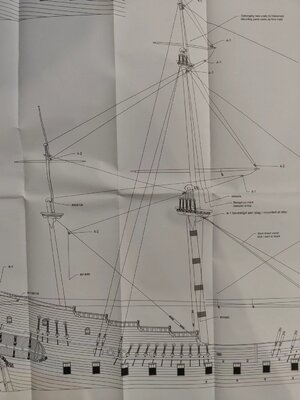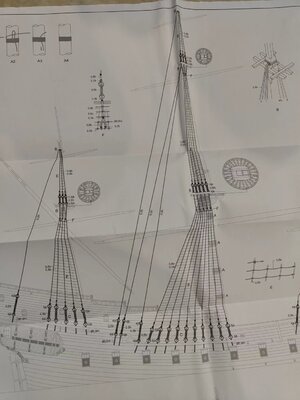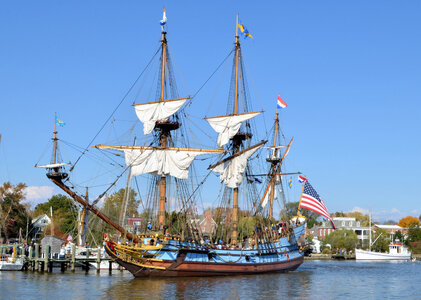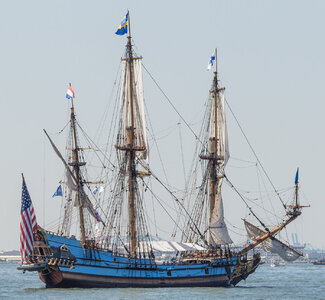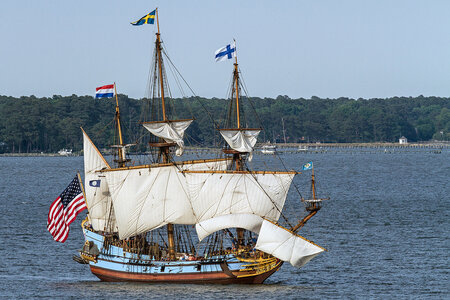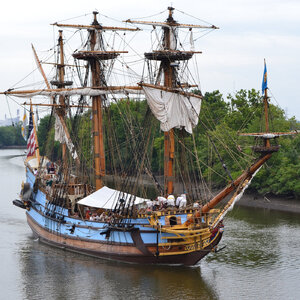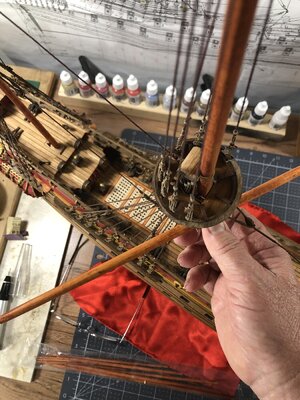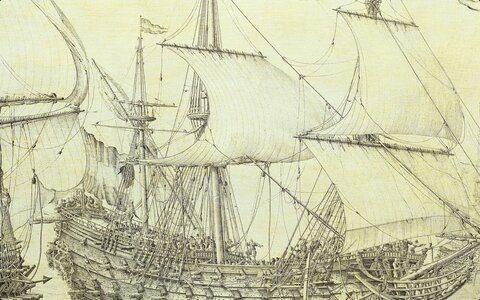Hi Paul, for backstays, I am seriously considering using the method shown by @Ab Hoving on his drawing of the Pinas. If you run the backstays from the chain plates you need to add the iron brace and strop which in my case is not a viable way but attached to the hull it works quite well. Was wondering what you and others might think.
-

Win a Free Custom Engraved Brass Coin!!!
As a way to introduce our brass coins to the community, we will raffle off a free coin during the month of August. Follow link ABOVE for instructions for entering.
You are using an out of date browser. It may not display this or other websites correctly.
You should upgrade or use an alternative browser.
You should upgrade or use an alternative browser.
Vasa - 1:65 DeAgostini [COMPLETED BUILD]
- Thread starter dockattner
- Start date
- Watchers 147
Yes, this is even better. Its right in the same time period as the Vasa! The Batavia backstays look like a permanent installation as opposed to a removable one attached with a pully tackle system. I'm on the fence with this only because of my hesitation to use my existing chain plates.
Actually, this is precisely the question I posed to Fred Hocker without response (again...understandably).Hi Paul, for backstays, I am seriously considering using the method shown by @Ab Hoving on his drawing of the Pinas. If you run the backstays from the chain plates you need to add the iron brace and strop which in my case is not a viable way but attached to the hull it works quite well. Was wondering what you and others might think.
His original email to me suggests that these backstays (one or two for the fore and main, one for the mizzen) ran to the channels (here I am referring to the horizontal wooden board - the chain wale) but were rigged with working tackles rather than deadeyes. The only way I can envision that is to add chainplates (here I am referring to the iron bit that attaches to the hull - my terminology might be flawed) and that doesn't make sense to me. We know how many chainplates are on the ship and I have used them all for shrouds. Were there fewer shrouds and one or two of the chainplates was used for backstays. I am unconvinced and deem that unlikely. That means the backstay must attach to a ringbolt (or other) on the hull right? Anyway, pending an answer from Mr. Hocker I think we are left with no other option. There is certainly a precedent for that arrangement on countless models.
Hi Paul, thank you so much for your reply. This backstay discussion is slowly starting to come into focus. I am at fault for not being clear on terminology, yes, the horizontal wood board is the chain wale, and the plate is the irons below. You have just solved my dilemma, since I do have room on the aft end of my fore and main chain wales, I will run backstays from the topgallant and topsail tops, fore and main mast, 1ea. port and starboard. It will take some creative redo to anchor the tackles. I have no extra room at the mizzen chain wales so an eye bolt into the hull will have to do there. Hopefully Mr. Hocker doesn't come back with 'stop the presses we have a new discovery'. Thanks again Paul and thanks again to Hienrich @Heinrich, for all your valuable help. I will give myself a little more time on this while doing ratlines.
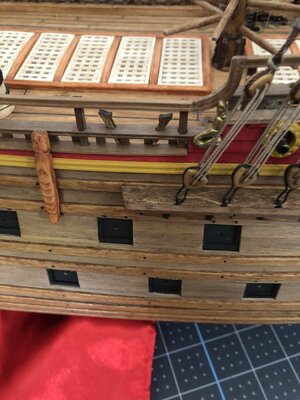

For the record, I'm thinking about not including backstays on the topgallant masts (though I have to see what it looks like without them). FH says they might have been used but can't be sure. You know, this would have been much easier to have just omitted them - that would be a very defendable choice given their historical uncertainty.
I too have considered the omission route but those long running backstay ropes look pretty cool (at least on my HMS Fly. I even have backstay ropes on the top of the flagpole coming all the way down to the chain wale).For the record, I'm thinking about not including backstays on the topgallant masts (though I have to see what it looks like without them). FH says they might have been used but can't be sure. You know, this would have been much easier to have just omitted them - that would be a very defendable choice given their historical uncertainty.
- Joined
- Aug 8, 2019
- Messages
- 5,475
- Points
- 738

There is a huge difference and change in rigging on ships between 1550 till 1650. You can't compare a ship of 1630 of the continental with a ship of 1650 from the continental. Or a Dutch ship or English ship of the same time. There was a lot of change every decade in these 100 years. Topgallant was mount, from 2 to 4 mast and back to 3 mast. The number of shrouds increase and decrease in that time by use of backstays. There is a lot of thinking about. Backstays where in their infancy in 1630. Most ships don't had them. So when you choose to attached them use the most simpel form, because the Vasa was most Likely on of the first ships that had backstays. So let it start behind a shroud on the channel (chainplate) on a eye bolt. And let it end on a simple tackel next to it or on a eye on the deck behind the channel. And use the form like this to keep the single block on the pendent high next to the top.
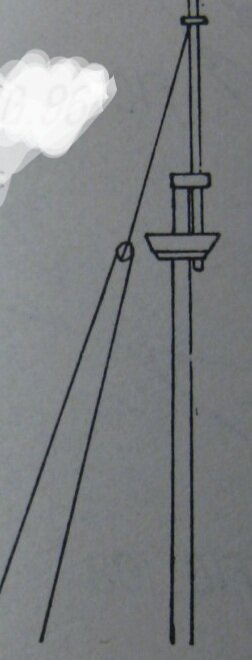

You are absolutely correct Stephen, I was only referring to the appearance of long running rope work and not the specifics of its rigging.There is a huge difference and change in rigging on ships between 1550 till 1650. You can't compare a ship of 1630 of the continental with a ship of 1650 from the continental. Or a Dutch ship or English ship of the same time. There was a lot of change every decade in these 100 years. Topgallant was mount, from 2 to 4 mast and back to 3 mast. The number of shrouds increase and decrease in that time by use of backstays. There is a lot of thinking about. Backstays where in their infancy in 1630. Most ships don't had them. So when you choose to attached them use the most simpel form, because the Vasa was most Likely on of the first ships that had backstays. So let it start behind a shroud on the channel (chainplate) on a eye bolt. And let it end on a simple tackel next to it or on a eye on the deck behind the channel. And use the form like this to keep the single block on the pendent high next to the top.
View attachment 307946
- Joined
- Aug 8, 2019
- Messages
- 5,475
- Points
- 738

I love this to. The block high in the sky. Lovely to see.appearance of long running rope
You know why it's done?
When they brace the sail, the yard will touch the backstay. On this whay they place the part with the tackle too the middle of the ship and the problem is solved. Just on one side of the mast this was done at one time.
backstays most likely shouldnt run to the same channels as shrouds but should be placed far apart to the aft , in this positions they will work more effectively
Stephan,
please tell me, how it possible "...When they brace the sail, the yard will touch the backstay...." I can't imagine such situation at all... when they brace the sail , yard will lay on the first couple of shrouds ... consider the first one could be slacked to gives more sharp angle... but how it will touch backstay???
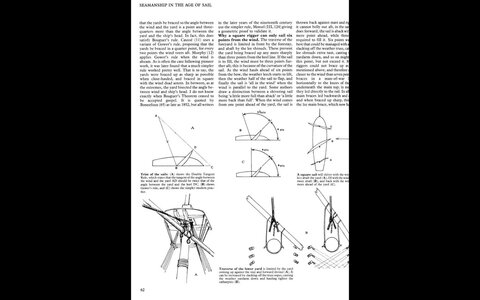
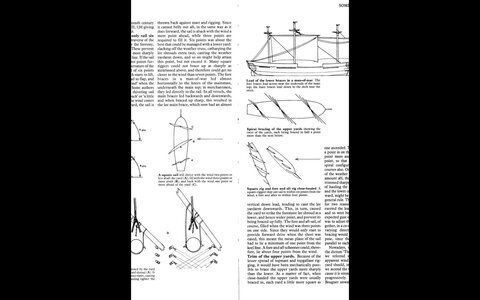
please tell me, how it possible "...When they brace the sail, the yard will touch the backstay...." I can't imagine such situation at all... when they brace the sail , yard will lay on the first couple of shrouds ... consider the first one could be slacked to gives more sharp angle... but how it will touch backstay???


Last edited:
Very interesting, all the more reason to have these lines movable with tackle (I think).I love this to. The block high in the sky. Lovely to see.
You know why it's done?
When they brace the sail, the yard will touch the backstay. On this whay they place the part with the tackle too the middle of the ship and the problem is solved. Just on one side of the mast this was done at one time.
Yes I can agree with you as well, so much for my sailing knowledge not to mention my inability to reason this out! Maybe because at the height of the yard the shrouds are so close to the mast that its possible for the yard to hit the backstay???Stephan,
please tell me, how it possible "...When they brace the sail, the yard will touch the backstay...." I can't imagine such situation at all... when they brace the sail , yard will lay on the first couple of shrouds ... consider the first one could be slacked to gives more sharp angle... but how it will toch backstay???
look at the pictures A and B from the book... for square sails it just impossible at any conditions


 But seriously though, the pinas was from 1674 and a much smaller ship than the VASA. Let me think ...
But seriously though, the pinas was from 1674 and a much smaller ship than the VASA. Let me think ...